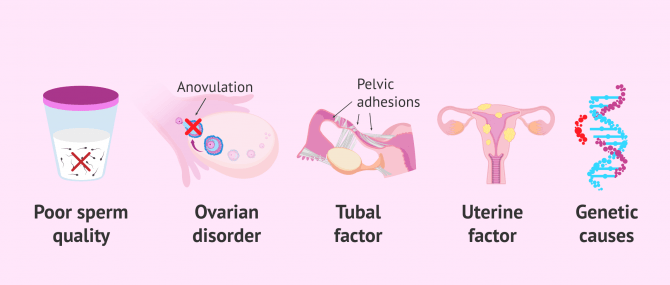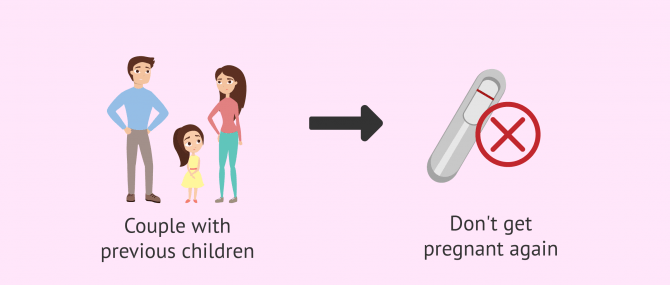The term sterility is defined as the inability to conceive after having been trying to get pregnant for over 12 months. On the other hand, by infertility we are referring to the impossibility of carrying a child until birth. In other words, a woman or couple is infertile when a full-term pregnancy is not possible.
But in practice, both sterility and infertility are used interchangeably by the vast majority of reproductive endocrinologists and infertility specialists.
Simultaneously, each term can be classified into two types:
- Primary sterility or infertility
- The woman has never been able to get pregnant, or she has but the pregnancy could not continue its full normal course at some point.
- Secondary sterility or infertility
- When a couple who already has a child experiences trouble trying to conceive a second child.
Provided below is an index with the 6 points we are going to expand on in this article.
- 1.
- 1.1.
- 2.
- 2.1.
- 2.2.
- 3.
- 3.1.
- 3.2.
- 3.3.
- 3.4.
- 3.5.
- 4.
- 5.
- 6.
Primary infertility
As explained above, a couple with primary infertility has never been able to conceive a child.
In order to render a diagnosis of primary infertility, it is necessary that the couple has been having unprotected intercourse for at least 12 months without luck. The next step is to visit a fertility specialist to run some fertility tests.
The first approach typically includes a semen analysis for the man. As for the woman, both an ultrasound scan and bloodwork are required. In case the cause of infertility is undetectable with these basic tests, other diagnostic tests will be run.
A couple's reproductive potential should be understood as the sum of the reproductive potential of the male plus the reproductive potential of the female.
Simply put, someone may experience infertility issues with a particular partner, but succeed on the first attempt with another, even if the cause of infertility is unknown. The explanation is that the sum of both reproductive potentials is insufficient to make a full-term pregnancy possible.
Causes
The reasons that lead to primary infertility are varied, and may have a male origin, female origin, or be the result of both. The following are the most common ones:
- Hormonal imbalances
- hypogonadism, hypothyroidism, etc.
- Poor sperm quality
- oligospermia, asthenospermia, teratozoospermia, etc.
- Ovary problems
- anovulation, Polycystic Ovary Syndrome (PCOS), early menopause, etc.
- Tubal factor
- salpingitis, endometriosis, hydrosalpinx, etc.
- Uterine factor
- uterine abnormalities, myomatosis, cervix disorders, etc.
- Genetic causes
- Turner syndrome, Klinefelter syndrome, etc.
- Others
- Sexually Transmitted Diseases (STDs), immune infertility, etc.
More often than not, a couple may go through temporary infertility, a type that reverses over time or with surgery if it is associated with some sort of anatomical anomalies, such as varicocele, endometrial polyps, septate uterus...
Secondary infertility
Secondary infertility occurs when a couple were able to conceive and give birth to a child in the past, but they are unable to conceive when attempting to have another baby.
Also, if one member of the couple is infertile but had children with another person previously, we speak of secondary infertility as well. Some experts, however, prefer to use the term tertiary infertility to refer to this particular circumstance.
From the social viewpoint, secondary infertility is not considered as severe as primary infertility, since at least the couple was able to have one child or even two children. But for the couple, being unable to increase the family size can turn out to be a stressful situation.
These patients typically feel misunderstood by family members and even doctors, who do not see their problem as a serious one.
Causes
In general, the causes of secondary infertility are very similar to those of primary infertility, which you can find listed above.
Nonetheless, it should be noted that secondary infertility is surprisingly common in our society, due simply to the passage of time.
Advanced maternal age, along with a decreased egg count (ovarian reserve), are the main causes of secondary infertility.
When a woman turns 35, her fertility experiences a dramatic decrease. This is the reason why getting pregnant now may be complicated, even if the couple was able to achieve pregnancy easily a few years ago.
Conditions associated or caused by the first pregnancy or inactive health issues at the moment of the first conception may appear as well, including diabetes, hyperprolactinemia, endometriosis, etc.
Practical example of secondary infertility
Dr. Gorka Barrenetxea provides us with a practical case of secondary infertility that occurs more commonly than one may think. A couple, throughout their lifetime, can have children with 20, 25, 30, and 35 years, but when they decide to have a second or third child, they may encounter trouble conceiving due to the passage of time itself, Dr. Barrenetxea states.
When someone decides to conceive, actually conceiving is not so easy. Pregnancy chances are determined based on age, but not all couples in the world achieve it on the first month. So, it is not uncommon for young couples with normal fertility parameters to need several months to get pregnant.
For example, let's imagine a 32-year-old couple who decides to get pregnant in January and achieves so in April. This means it has taken 4 months for them to succeed. In other words, that they failed in January, February, and March. Their possibilities were 25% per month.
Obviously, if the same couple decides to have more children at age 38, the chances won't be 25% anymore; it is likely that they are about 10%, which translates into a reduced pregnancy chance. This does not mean the couple has become infertile. Since they weren't absolutely fertile at age 32, it is only logical that their pregnancy chances at 38 are so low.
FAQs from users
What is primary sterility?
Primary infertility is defined as the inability for a couple to achieve a pregnancy, either because the sperm is unable to hit the egg cell, or because the embryo cannot attach to the woman's endometrial lining and give rise to a new pregnancy after a successful fertilization.
What is primary infertility?
Primary infertility is defined as the impossibility for a couple to have a full-term pregnancy, that is, a pregnancy that leads to the birth of a healthy baby. In other words, the man is able to get his partner pregnant, but the woman cannot carry the child until birth and miscarries.
A common fertility issue associated with primary infertility are recurrent miscarriages. Learn more: What Is Recurrent Miscarriage? – Causes, Symptoms & Treatment.
What is secondary sterility?
Secondary sterility is defined as the inability for a couple to conceive after having been able to achieve pregnancy and give birth to a healthy child previously.
The causes of secondary sterility are age, in the case of females, and poor sperm quality, in the case of males.
For this reason, a number of couples with secondary sterility are referred to egg donation to become parents again.
Do primary and secondary sterility have the same causes?
No. The causes of primary and secondary infertility are not the same, but may be due to different problems. Therefore, the protocols of action will also be different according to the factor that triggers the difficulty in achieving pregnancy, as well as the possible solutions to be able to have offspring.
What is secondary infertility?
Secondary infertility appears when, after a normal pregnancy and delivery, the couple experiences trouble when they try to achieve a new full-term pregnancy to have a second child.
Simply put, the woman gets pregnant, but the pregnancy ends up in miscarriage due to several causes, including obstetric complications linked to age.
Suggested for you
If you wish to learn more about the reasons that cause infertility and the potential solutions, we recommend that you click here: What Are the Main Causes of Infertility?
On the other hand, if you have been diagnosed with primary or secondary infertility and have decided to visit a fertility specialist, you might be interested in reading this guide: What Are Infertility Treatments? – Definition, Types & Costs.
We make a great effort to provide you with the highest quality information.
🙏 Please share this article if you liked it. 💜💜 You help us continue!
References
Vidal C. Esterilidad e infertilidad humanas. Abordaje y tratamiento. Farmacia Profesional 2001; 15(8): 5-101
Matorras R, Hernández J (eds) (2007): Estudio y tratamiento de la pareja estéril: Recomendaciones de la Sociedad Española de Fertilidad, con la colaboración de la Asociación Española para el Estudio de la Biología de la Reproducción, de la Asociación Española de Andrología y de la Sociedad Española de Contracepción. Adalia, Madrid.
Royal College of Obstetricians and Gynaecologists. Fertility: assessment and treatment for people with fertility problems. NICE Clinical Guideline. February 2013.
Prof. Mary Wingfield (2017). The Fertility Handbook: Everything You Need to Know to Maximise Your Chance of Pregnancy, Gill & Macmillan Ltd, May 29, 2017
FAQs from users: 'What is primary sterility?', 'What is primary infertility?', 'What is secondary sterility?', 'Do primary and secondary sterility have the same causes?' and 'What is secondary infertility?'.






Hello,
I already have two children, now planning for my third. However, I have repeated pregnancy losses, I don’t understand what the causes might be. Is this secondary infertility and what can I do?
Hi Micha,
since you already have children and have trouble maintaining your pregnancy, we speak of secondary sterility. Sterility occurs when there is fertilization but pregnancy won’t be carried to term while in infertility you wouldn’t conceive in the first place.
Here in this post, you can read the causes of repeated miscarriages and your pregnancy options: What Is Recurrent Miscarriage? – Causes, Symptoms & Treatment.
Hope this helps,
All the best.